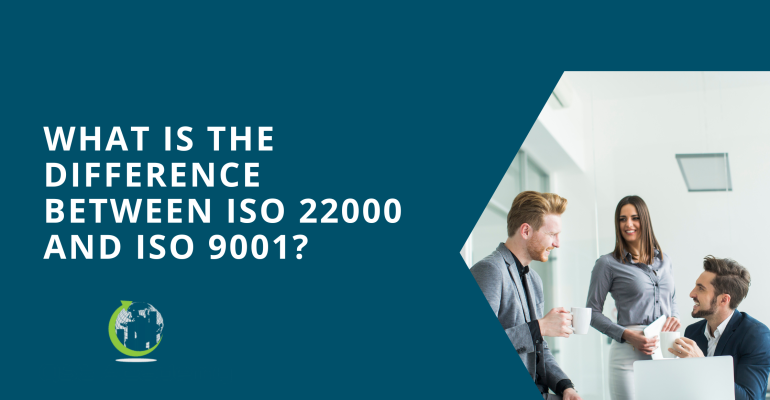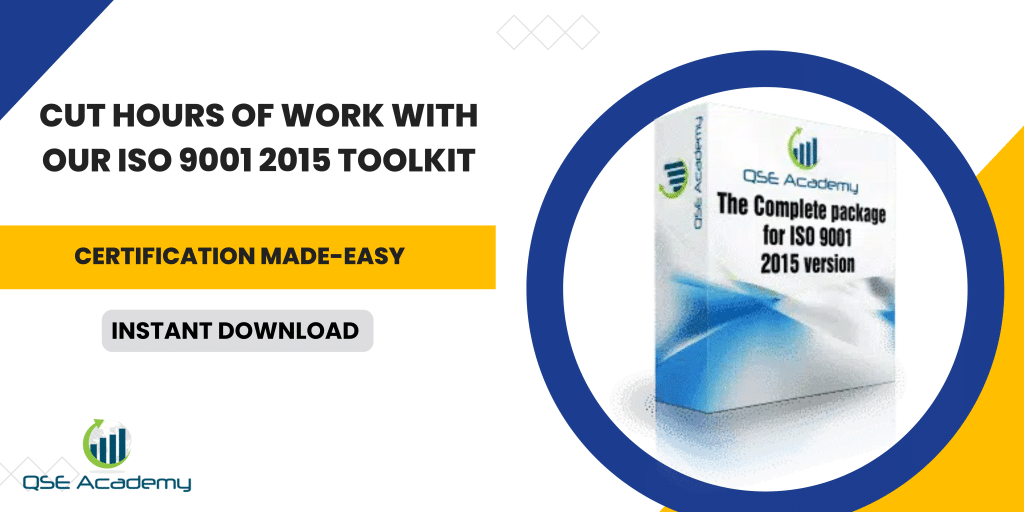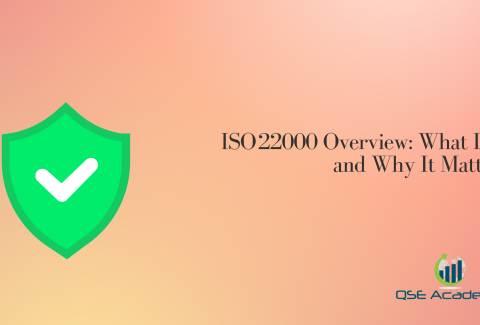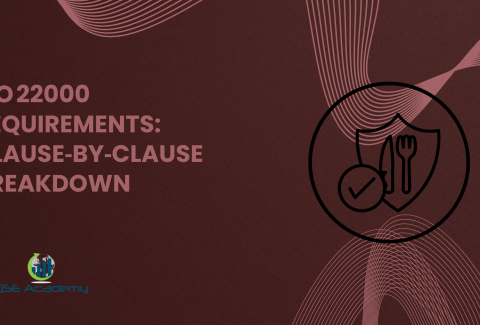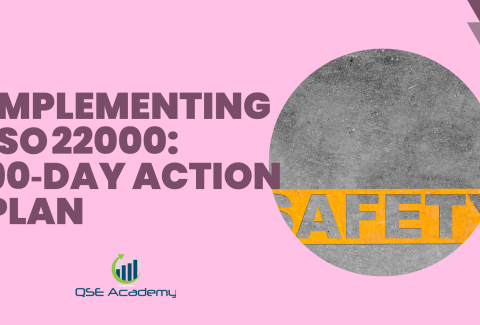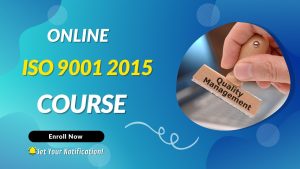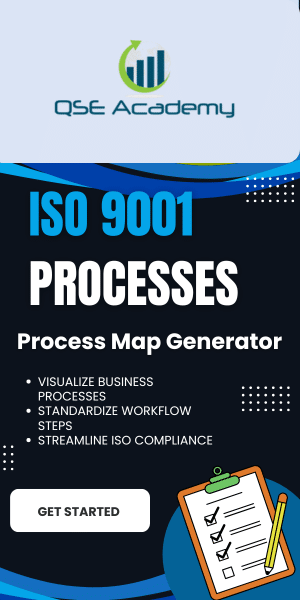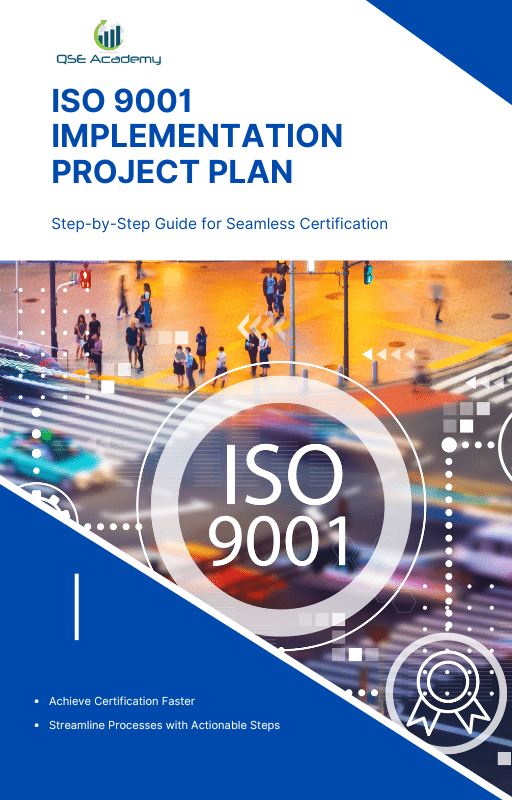What is the difference between ISO 9001 and ISO 22000?
Last Updated on October 13, 2025 by Hafsa J.
What is the difference between ISO 9001 and ISO 22000?
If you’ve ever explored international standards for quality and safety, you’ve probably come across ISO 9001 and ISO 22000. At first glance, they might seem similar—they both aim to improve business processes and deliver better results. But when you take a closer look, you’ll see that they serve very different purposes. So, what is the difference between ISO 9001 and ISO 22000? Let’s break it down.
ISO 9001 is all about quality management. It’s a versatile standard used across industries to ensure consistency, customer satisfaction, and efficient operations. Whether you’re running a tech startup, a manufacturing plant, or a consulting firm, ISO 9001 gives you the framework to deliver reliable, high-quality outcomes.
On the other hand, ISO 22000 focuses specifically on food safety. It’s designed for businesses in the food industry, helping them ensure that the food they produce, handle, or distribute is safe for consumption. From farm to fork, ISO 22000 emphasizes preventing hazards and meeting strict regulatory requirements.
Understanding the difference between ISO 9001 and ISO 22000 is crucial for businesses deciding which standard to implement—or whether to integrate both. In this article, we’ll dive into what makes these standards unique, how they overlap, and why choosing the right one (or both!) can be a game-changer for your organization. Let’s get started!
Understanding ISO 9001 and ISO 22000 Basics
To truly understand the difference between ISO 9001 and ISO 22000, let’s start by breaking down what each standard is all about. While they both focus on improving processes and outcomes, their goals and applications differ significantly.
What is ISO 9001?
ISO 9001 is the go-to standard for Quality Management Systems (QMS). It’s designed to help organizations ensure they’re consistently meeting customer expectations while improving overall efficiency. The beauty of ISO 9001 is its flexibility—it can be applied across industries, whether you’re in manufacturing, healthcare, IT, or retail.
For example, a company producing electronic components might use ISO 9001 to standardize their processes, reduce defects, and maintain consistent quality in every product. In essence, ISO 9001 is all about delivering quality products and services while keeping customers happy.
So, when we talk about the difference between ISO 9001 and ISO 22000, one key distinction is that ISO 9001 applies to any industry, whereas ISO 22000 is more specialized.
What is ISO 22000?
Now let’s talk about ISO 22000. This standard is specifically tailored for the food industry, focusing on Food Safety Management Systems (FSMS). Its primary goal is to ensure that food products are safe for consumption at every stage of the supply chain, from raw materials to the final product on a consumer’s plate.
ISO 22000 incorporates elements like Hazard Analysis and Critical Control Points (HACCP), which are essential for identifying and managing food safety risks. For example, a dairy company might use ISO 22000 to ensure their milk is processed, stored, and distributed under safe conditions, reducing the risk of contamination.
Here’s another key difference between ISO 9001 and ISO 22000: ISO 9001 focuses on quality and consistency, while ISO 22000 zeroes in on preventing food safety hazards.
Why Do These Standards Matter?
Both ISO 9001 and ISO 22000 aim to improve processes and build trust, but they serve different purposes. ISO 9001 is about delivering quality, no matter the product or service, while ISO 22000 ensures that food is safe for consumers. Understanding these distinctions helps businesses choose the right standard—or even combine them for a comprehensive approach.
In the next section, we’ll explore the similarities that link these two standards and why they’re often complementary. Keep reading to see how they work together and what sets them apart!
Key Similarities Between ISO 9001 and ISO 22000
Before we dive deeper into the difference between ISO 9001 and ISO 22000, let’s talk about what these two standards have in common. After all, they’re both developed by the International Organization for Standardization (ISO) and share some foundational principles that make them globally recognized and widely adopted.
1. Both Are International Standards
One of the most significant similarities is that ISO 9001 and ISO 22000 are both internationally recognized standards. This means they’re trusted frameworks used by businesses all over the world. Whether you’re a small bakery in Europe or a global electronics manufacturer in Asia, these standards help you align your processes with best practices and gain credibility in the global market.
For example, a food company certified to ISO 22000 can assure customers anywhere in the world that their products meet strict food safety requirements. Similarly, a tech company certified to ISO 9001 can demonstrate their commitment to consistent quality. While the focus differs, both standards build trust and boost reputations.
Another similarity lies in their structure. Both ISO 9001 and ISO 22000 follow the Annex SL framework, a standardized format used for all modern ISO management system standards.
What does this mean in practice? The chapters in both standards are organized similarly, covering areas like leadership, planning, support, and continuous improvement. This makes it easier for organizations to integrate multiple ISO standards. For instance, a food manufacturer could implement ISO 22000 for food safety and ISO 9001 for overall quality management without duplicating efforts.
This shared structure is particularly helpful for businesses that want to adopt both standards, showing how they complement each other despite the difference between ISO 9001 and ISO 22000.
3. Focus on Risk Management and Improvement
Both ISO 9001 and ISO 22000 emphasize risk management and continuous improvement, albeit in slightly different ways. ISO 9001 focuses on identifying risks that might affect the quality of products or services, while ISO 22000 hones in on food safety risks like contamination or spoilage.
For example, ISO 22000 requires businesses to implement a Hazard Analysis and Critical Control Points (HACCP) plan to prevent food safety hazards. On the other hand, ISO 9001 encourages businesses to proactively address risks that could impact customer satisfaction, like delays in production or inconsistent service.
Both standards also require regular performance reviews, audits, and updates to ensure ongoing improvement. This shared commitment to better processes highlights another connection between the two standards, even as the difference between ISO 9001 and ISO 22000 remains clear.
How These Similarities Benefit Businesses
The shared principles of ISO 9001 and ISO 22000 make them complementary tools for businesses, especially those in the food industry. For example, a food production company might use ISO 22000 to ensure food safety while leveraging ISO 9001 to optimize quality and efficiency across all operations.
In the next section, we’ll explore the core differences that set these two standards apart, helping you understand which one might be the right fit—or why adopting both could be a smart move. Let’s keep going!
Core Differences Between ISO 9001 and ISO 22000
Now that we’ve looked at how ISO 9001 and ISO 22000 overlap, let’s dive into what sets them apart. The difference between ISO 9001 and ISO 22000 lies in their focus, purpose, and how they are applied in businesses. Understanding these distinctions will help you decide which standard (or both) is right for your organization.
1. Scope and Purpose
The most significant difference between ISO 9001 and ISO 22000 is their scope. ISO 9001 is a general standard for Quality Management Systems (QMS) that can be applied to any industry, while ISO 22000 is specifically tailored for food safety management.
- ISO 9001: This standard focuses on ensuring consistent quality across all products or services, regardless of industry. It’s about delivering results that meet customer expectations, whether you’re in manufacturing, IT, retail, or healthcare.
- ISO 22000: On the other hand, ISO 22000 is all about food safety. It ensures that food products are safe for consumption by identifying, controlling, and preventing hazards throughout the supply chain. From farms and food processing plants to packaging and delivery, ISO 22000 focuses on every step of the food production process.
Simply put, while ISO 9001 focuses on quality for any type of business, ISO 22000 is designed to address the specific needs of the food industry.
2. Primary Objectives
Another key difference between ISO 9001 and ISO 22000 is their primary objectives.
- ISO 9001’s Goal: Customer satisfaction and operational efficiency are at the heart of ISO 9001. This standard helps organizations improve processes, reduce waste, and ensure that customers receive consistent, high-quality results.
- ISO 22000’s Goal: ISO 22000 is focused on preventing foodborne hazards and ensuring regulatory compliance. It prioritizes food safety as the top objective, ensuring that every food product is safe for consumers.
While both aim to improve operations, ISO 9001 is more about quality management as a whole, whereas ISO 22000 zeroes in on food safety.
3. Industry-Specific Requirements
Another difference between ISO 9001 and ISO 22000 is that ISO 22000 includes specific requirements for food safety that ISO 9001 does not.
ISO 22000 incorporates Hazard Analysis and Critical Control Points (HACCP), a systematic approach to identifying, evaluating, and controlling food safety hazards. This is a critical component for businesses that handle, process, or distribute food.
For example, a bakery using ISO 22000 would have procedures in place to monitor critical control points, such as ensuring the proper temperature of ovens or preventing cross-contamination during packaging. ISO 9001, while focusing on quality management, doesn’t include such food-specific requirements.
4. Documentation and Compliance
Both ISO 9001 and ISO 22000 require documentation, but the type of documentation needed differs based on their objectives.
- ISO 9001: Documentation in ISO 9001 focuses on quality objectives, customer feedback, and process controls. It ensures that everyone follows standardized practices to maintain consistency and quality.
- ISO 22000: In contrast, ISO 22000 requires detailed records related to food safety, such as hazard analyses, control measures, and monitoring results. The documentation ensures that every step in the food supply chain meets stringent safety standards.
This makes ISO 22000 more specific and detailed when it comes to food-related processes, while ISO 9001 takes a broader approach.
Why These Differences Matter
Understanding the difference between ISO 9001 and ISO 22000 is essential for businesses deciding which standard to implement. If your organization works in food production, handling, or distribution, ISO 22000 is critical for ensuring food safety. But if your focus is on delivering consistent quality in any industry, ISO 9001 is the way to go.
In some cases, businesses—especially those in the food industry—choose to implement both standards to cover all bases. In the next section, we’ll explore how companies make this decision and how the standards can complement each other. Keep reading to find out!
Choosing Between ISO 9001 and ISO 22000
Now that you understand the difference between ISO 9001 and ISO 22000, the next step is deciding which standard—or combination of both—is right for your business. The choice largely depends on your industry, objectives, and the unique challenges your organization faces. Let’s break it down together.
1. Does Your Business Focus on Food Safety?
If your organization is involved in the food industry—whether you’re farming, manufacturing, processing, packaging, or distributing food—ISO 22000 is a must-have. It’s specifically designed to address food safety risks and ensure that products are safe for consumption.
For example, a catering company might use ISO 22000 to establish rigorous hygiene practices in their kitchens and monitor critical control points, like food storage temperatures, to prevent contamination. By implementing this standard, they can build trust with customers and meet regulatory requirements.
In this case, the difference between ISO 9001 and ISO 22000 becomes clear: ISO 22000 focuses entirely on food safety, while ISO 9001 doesn’t cover the specific hazards related to food.
2. Do You Need a General Quality Framework?
If your organization operates outside the food industry or focuses on quality management for products or services, ISO 9001 is likely the better choice. It provides a versatile framework for improving efficiency, reducing errors, and consistently meeting customer expectations—no matter your industry.
For instance, a software development company could use ISO 9001 to streamline its coding processes, minimize bugs, and ensure that clients receive high-quality products on time.
Here’s another way to think about it: if your primary goal is to improve overall quality and customer satisfaction, ISO 9001 is the go-to standard. However, if food safety is your main concern, ISO 22000 is the better fit.
3. Can ISO 9001 and ISO 22000 Work Together?
Yes! In fact, many businesses—particularly those in the food industry—choose to implement both ISO 9001 and ISO 22000. Why? Because these standards complement each other beautifully.
ISO 22000 ensures that food products are safe, while ISO 9001 takes a broader approach by improving the quality and efficiency of all operations. Together, they create a comprehensive system that covers both safety and quality.
For example, a food production company might use ISO 22000 to prevent contamination during processing and ISO 9001 to optimize packaging workflows, reduce waste, and enhance customer satisfaction. By combining the two, they achieve better outcomes across the board.
4. Consider Your Business Goals
When deciding between ISO 9001 and ISO 22000, start by identifying your organization’s goals and challenges:
- Are you primarily focused on customer satisfaction, efficiency, and overall quality? ISO 9001 is a great choice.
- Are you in the food industry and need to ensure the safety of your products? ISO 22000 is essential.
- Do you want to address both food safety and general quality management? Consider implementing both standards for maximum impact.
Understanding the difference between ISO 9001 and ISO 22000 and how they align with your goals will help you make the right decision for your business.
A Strategic Approach to Standards
Choosing the right standard (or combination of standards) isn’t just about compliance—it’s about improving your processes, building trust with customers, and achieving long-term success. In the next section, we’ll look at real-world examples of how organizations use ISO 9001, ISO 22000, or both to meet their goals. Let’s keep going!
Real-World Examples of the Difference Between ISO 9001 and ISO 22000
Sometimes the best way to truly understand the difference between ISO 9001 and ISO 22000 is to see how they’re applied in real-world situations. Let’s explore some examples of how businesses across various industries use these standards to achieve their goals.
1. Manufacturing Company: ISO 9001 for Product Quality
Imagine a company that produces electronic components used in household appliances. Their primary focus is ensuring that every batch of components meets strict quality standards so that their clients can rely on their products.
This company might implement ISO 9001 to standardize their production processes, improve efficiency, and reduce defects. By tracking performance metrics and gathering customer feedback, they can continuously improve and ensure their products consistently meet customer expectations.
In this case, the company doesn’t need to address food safety concerns, so ISO 9001 perfectly suits their needs. The difference between ISO 9001 and ISO 22000 here is clear: ISO 9001 focuses on overall quality management, while ISO 22000 isn’t relevant to non-food industries like electronics.
2. Food Manufacturer: ISO 22000 for Food Safety
Now, let’s consider a dairy processing company that produces milk, cheese, and yogurt. Their top priority is ensuring that their products are safe to consume and meet stringent food safety regulations.
This company would implement ISO 22000 to establish a Food Safety Management System (FSMS). Using Hazard Analysis and Critical Control Points (HACCP), they can identify and control risks like contamination during processing or storage. The company might also use ISO 22000 to document cleaning procedures, monitor temperature controls, and conduct regular audits to ensure compliance with food safety standards.
For this business, food safety is non-negotiable, making ISO 22000 the ideal standard. While ISO 9001 could help with broader quality management, the difference between ISO 9001 and ISO 22000 lies in ISO 22000’s specific focus on food safety hazards.
3. Dual-Certified Food Business: Combining ISO 9001 and ISO 22000
Now, let’s look at a company that produces packaged snacks sold globally. Their goals are twofold: they need to ensure the safety of their food products while also maintaining high-quality production standards to keep customers satisfied.
This company might choose to implement both ISO 9001 and ISO 22000. ISO 22000 helps them address food safety concerns, like preventing contamination during production and ensuring proper storage conditions. At the same time, ISO 9001 helps them improve overall efficiency, reduce waste, and standardize processes like packaging and logistics.
By integrating both standards, they create a comprehensive system that covers everything from food safety to operational quality. This highlights how the difference between ISO 9001 and ISO 22000 can actually work to their advantage when implemented together.
4. Service-Oriented Business: ISO 9001 for Customer Satisfaction
Lastly, consider a logistics company that specializes in transporting goods. Their success depends on timely deliveries, reliable service, and effective communication with clients.
For this company, ISO 9001 is the clear choice. It helps them create standardized processes for tracking shipments, managing customer inquiries, and ensuring on-time delivery. Regular performance evaluations and customer feedback help them continuously improve their operations.
Since this business isn’t involved in food production or handling, ISO 22000 isn’t necessary. This example underscores the difference between ISO 9001 and ISO 22000: ISO 9001 is versatile and applies to any industry, while ISO 22000 is tailored for the food sector.
Lessons from Real-World Applications
These examples show how businesses use ISO 9001 and ISO 22000 to address their unique challenges. Whether it’s improving product quality, ensuring food safety, or combining both standards for maximum impact, the difference between ISO 9001 and ISO 22000 plays a key role in determining the best fit.
In the next section, we’ll wrap up everything we’ve covered and help you decide how these standards can benefit your organization. Stay tuned!
Conclusion: Understanding the Difference Between ISO 9001 and ISO 22000
By now, you have a clear picture of the difference between ISO 9001 and ISO 22000 and why these two standards are so valuable for businesses. While they share similarities in structure and principles, their applications and objectives set them apart. Understanding these differences can help you make informed decisions about which standard—or combination of standards—is right for your organization.
ISO 9001: The Gold Standard for Quality Management
ISO 9001 is all about creating consistency, improving efficiency, and delivering customer satisfaction. It’s a versatile standard that works across industries, making it the go-to choice for businesses looking to optimize operations and maintain high-quality outcomes. Whether you’re running a manufacturing plant or providing professional services, ISO 9001 ensures you’re meeting customer expectations and continually improving.
ISO 22000: The Essential Standard for Food Safety
On the other hand, ISO 22000 is specifically tailored to the food industry, focusing on preventing food safety hazards and ensuring compliance with strict regulations. It’s the perfect solution for businesses involved in food production, processing, or distribution that want to build trust with customers by delivering safe, high-quality products.
Choosing the Right Standard for Your Business
The decision comes down to your organization’s needs:
- If you’re outside the food industry and focused on overall quality, ISO 9001 is likely the best fit.
- If food safety is your priority, ISO 22000 is essential.
- And if you’re in the food sector and want to cover both quality and safety, implementing both standards can be a powerful strategy.
For example, a food production company could use ISO 22000 to manage food safety risks and ISO 9001 to optimize packaging and distribution processes. The difference between ISO 9001 and ISO 22000 becomes a strength when used together.
Final Thoughts
Both ISO 9001 and ISO 22000 are incredible tools for improving processes, building trust, and driving success. Whether you’re looking to meet customer expectations, ensure food safety, or achieve both, these standards provide the frameworks you need to thrive.
So, which standard will you choose? Or perhaps you’ll use both to create a comprehensive management system that covers quality and safety? Whatever you decide, understanding the difference between ISO 9001 and ISO 22000 is the first step toward making the right choice for your business.
Ready to take your organization to the next level? Start exploring these standards today and unlock the benefits they bring!
Ready to move from ISO 9001 theory to implementation?
Get the exact tools you need to write your documentation, train your team, map your processes, and pass your audit—without wasted time or guesswork.

make ISO standards less intimidating and more approachable for everyone.
Whether it’s ISO 9001, ISO 22000, or the cosmetics-focused ISO 22716, I’ve spent my career
turning complex jargon into clear, actionable steps that businesses can actually use.
I’m not here to call myself an expert—I prefer “enthusiast” because I truly love what I do.
There’s something incredibly rewarding about helping people navigate food safety and quality management systems
in a way that feels simple, practical, and even enjoyable.
When I’m not writing about standards, you’ll probably find me playing Piano 🎹, connecting with people, or diving into my next big project💫.
I’m an engineer specialized in the food and agricultural industry
I have a Master’s in QHSE management and over 12 years of experience as a Quality Manager
I’ve helped more than 15 companies implement ISO 9001, ISO 22000, ISO 22716, GMP, and other standards
My clients include food producers, cosmetics manufacturers, laboratories, and service companies
I believe quality systems should be simple, useful, and efficient.

